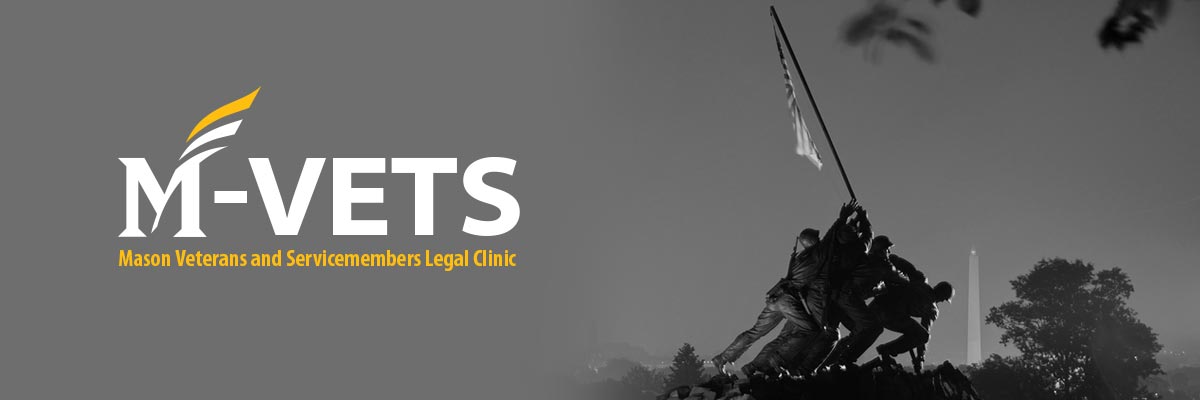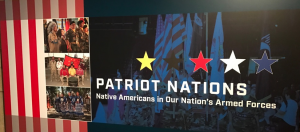
By Spring 2017 M-VETS Student-Advisor Monica Martinez
Native Americans have served our nation valiantly and with distinction in times of peace and war, while also fighting for the right to be an equal part of this very nation. To honor their legacy, Patriot Nations: Native Americans in Our Nation’s Armed Forces, an exhibition that tells the history of American Indian and Alaska Native men and women who have served in the United States military, will be available for viewing until January 18, 2018 at the Smithsonian Institution’s National Museum of the American Indian (NMAI) in Washington, D.C.
NMAI will also be the site of the National Native American Veterans Memorial, a project authorized by Congress in December 2013 with an anticipated dedication date of Veterans Day, November 11, 2020. The memorial will highlight the bravery, contributions, and sacrifices of American Indian, Alaska Native, and Native Hawaiian veterans during their military service. The $15 million memorial project, which will receive no federal funds, tasks NMAI and the National Congress of American Indians (NCAI)—an advocacy organization—with accepting contributions for, and paying the expenses of its establishment. To garner support and community input for the memorial, an advisory committee consisting of Native representatives from various tribes and branches of service will conduct a series of consultations this summer. There have been 30 such consultations to date and several more are planned over the next few months.
Commitment to Military Service
Native Americans comprise a rapidly growing segment of the U.S. military and veteran population. Yet military service has not been without sacrifice. Native Americans have honorably defended the U.S., despite a tragic history of cultural suppression, broken treaties, and confinement to reservations. At home, Native American veterans are some of the most revered members of their communities, recognized on special occasions through ceremonies and dances performed in their honor. Native Americans’ reasons for serving in the military are complex. While some see military service as an extension of their warrior traditions, or believe in a sacred purpose to protect their land, others join simply to fulfill the patriotic sense of duty felt by every American.
The Department of Defense estimates that some 31,000 American Indian and Alaska Native (AIAN) men and women are on active duty. According to the Census Bureau, more than 140,000 veterans self-identify as AIAN. American Indians have the highest per capita commitment to military service than any other ethnic group in the United States.
Overview of Native American Military Service
Native Americans served in the Army in every war in America’s history, as well as during peacetime, and even when unrecognized as American citizens. Additionally, 25 Native Americans have received the nation’s highest award for valor, the Medal of Honor. Below is a selection of highlights as compiled by the Department of Defense of Native American military service through the years.
Ira Hayes – Iwo Jima Flag Raiser
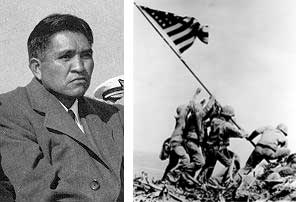
On Feb. 23, 1945, to signal the end of Japanese control, Ira Hayes and five other’s raised the U. S. flag atop Mount Suribuchi on the island of Iwo Jima. Three of the six men were killed while raising the flag. The heroic act transformed Hayes’ life forever. Hayes was a full-blood Pima Indian from Arizona, and is buried in Arlington Cemetery. The Ballad of Ira Hayes, a popular folk song performed by Johnny Cash, tells his story.
Early Wars (before World War I)
Many tribes were involved in the War of 1812, having fought for both sides as auxiliary troops in the Civil War. The Indian Scouts were established in 1866 and remained active for the remainder of the nineteenth century and the early twentieth century.
World War I
Roughly 12,000 Native Americans served in the military during World War I. Four Native Americans serving in the 142nd Infantry of the 36th Texas-Oklahoma National Guard Division received the Croix de Guerre medal from France.
World War II
Over 44,000 Native Americans served between 1941 and 1945, (from a population of less than 350,000). Native American military personnel worked as cryptologists, using their Native languages to encode messages so that enemy code-breakers could not decipher them. Alaska Natives were a significant presence on the Alaska Combat Intelligence Detachment. This outfit was the first ashore on each island occupied by Allied forces in the Aleutian Campaign. Women contributed to war efforts through volunteer emergency service (WAVES), Women’s Army Corps, and Army Nurse Corps.
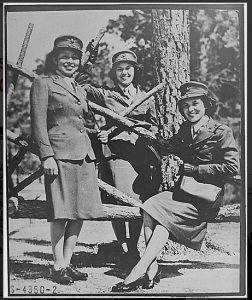
Marine Corps Women Reservists, Camp Lejeune, North Carolina, Oct. 16, 1943. From left, Minnie Spotted Wolf (Blackfoot), Celia Mix (Potawatomi) and Viola Eastman (Chippewa).
Korean War
Approximately 10,000 Native Americans served in the military during this period. Three were awarded the Medal of Honor.
Vietnam War
More than 42,000 Native Americans served in the military in the Vietnam Era, and over 90 percent of those servicemembers were volunteers.
Post-Vietnam Era
Native American servicemembers continued to serve in high numbers after the Vietnam Era—in Grenada, Panama, Somalia, the Gulf War, and in Operation Enduring Freedom (OEF), Operation Iraqi Freedom (OIF), and Operation New Dawn (OND).
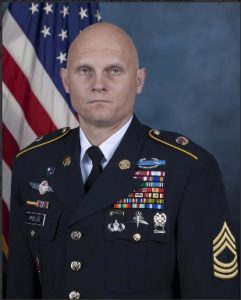
Master Sergeant Joshua Wheeler (Cherokee, 1975–2015) was a member of the army’s elite Delta Force and the recipient of 11 Bronze Stars during his military career. Wheeler died on Oct. 22, 2015, while rescuing prisoners from the Islamic State (ISIS) near Hawijah in northern Iraq. He was the first known U.S. military casualty in the fight against ISIS.
Challenges Facing Native American Veterans
Native American communities are committed to creating paths to education, active citizenship, career development, and improved health outcomes for returning servicemembers and veterans in order to ease the transition home, but challenges remain. American Indian and Alaska Native (AIAN) veterans, for example, are less likely to have an advanced degree compared to veterans of other ethnic groups. AIAN populations also have lower personal incomes than veterans of other ethnic groups and, though the unemployment rate for all veterans has risen since the economic downturn, the unemployment rate for those living on tribal lands has been higher. Further, AIAN veterans are more likely to lack health insurance and to have a disability, service-connected or otherwise, than veterans of other ethnic groups. In the area of mental health, increasing evidence shows that Native American veterans have the highest rate of PTSD of any ethnic group. Significant barriers to identifying and treating these conditions include lack of sufficient health literacy and confusion regarding eligibility for veterans services or the types of services available. However, geography poses the greatest challenge to receiving care, since reservations in rural and remote areas are at great distances from medical facilities. For veterans within or near rural communities, it can be also be difficult to receive representation for benefit claims because they cannot reach existing veterans service organizations (VSOs) or may not use them due to cultural barriers.
Federal Benefits for Native American Populations
The U.S. Department of Veterans (VA) affairs works through tribal governments to provide benefits and services to Native American veterans. VA has tried to address the lack of benefits representation in Native communities through a rule change in the Code of Federal Regulations (38 CFR 14.628). The change will allow eligible tribal organizations to become accredited by the VA to provide assistance on benefit claims. Other resources include the VA Veterans Benefit Administration (VBA), which administers a Native American Direct Home Loan (NADL) program with assistance from the Office of Tribal Government Relations (OTGR); and the VA Veterans Health Administration (VHA) Office of Rural Health, which administers telemental health clinics that provide mental health services remotely to rural veterans. Also, a new program through the Tribal HUD-VA Supportive Housing (Tribal HUD-VASH) program will provide rental assistance and supportive services to homeless Native American veterans or those at risk of homelessness. (This list provides only a brief overview of federal benefits available to Native American veterans.)
I. Veterans Service Organizations
The VA issued a final rule on January 19, 2017, to amend its regulations concerning recognition of certain national, state, and regional or local organizations for purposes of VA claims representation. Specifically, the rulemaking allows the Secretary to recognize tribal organizations in a similar manner as the Secretary recognizes state organizations. The final rule allows a tribal organization that is established and funded by one or more tribal governments to be recognized for the purpose of providing assistance on VA benefit claims. It also allows an employee of a tribal government to become accredited through a recognized state organization, similar to County Veterans’ Service Officer (CVSO) accreditation. Accredited tribal organizations will provide veterans with better, more culturally competent services through stringent requirements meant to secure long-term, quality representation.
II. VA Direct Home Loan Program
VA provides direct home loans to eligible Native American veterans to finance the purchase, construction, or improvement of homes on Federal Trust Land, or to refinance a prior NADL to reduce the interest rate. To obtain a NADL, the law requires that the tribal government must have signed a Memorandum of Understanding (MOU) with the Secretary of Veterans Affairs. The MOU spells out the conditions under which the program will operate on its trust lands. The NADL will allow Native American veterans to reintegrate more easily into civilian working life and to secure a brighter future for their families.
III. HUD Supportive Housing Program
Tribal HUD VASH, a new program, is estimated to benefit 500 Native American veterans through the form of housing and supportive services. The program will combine $5.9 million in rental assistance from HUD with case management and clinical services provided by VA. Veterans who are homeless or at risk of homelessness and who are living on or near a reservation or other Indian areas are eligible for assistance. Through this innovative program, HUD hopes to help tribes move one step closer to ending veteran homelessness once and for all.
As the foregoing demonstrates, partnerships between Native American communities and federal government agencies have the potential to enhance the health, social, and economic outcomes not only for the returning Native servicemember, but for his entire family.
Patriot Nations
Just as the NMAI exhibition introduces many museum patrons to the historical sacrifices of Native Americans in the armed forces, the National Memorial will stand as a stunning tribute in the nation’s capital to allow us to reflect on that legacy of service. At the same time, we must continue to recognize and address the challenges inherent in serving Native American veterans. Cultural barriers, lack of information, and geography are a few factors that prevent Native American veterans from receiving excellent service-connected care and benefits. Through continued partnerships with national advocacy organizations like NCAI, and federal government agencies, these and other critical issues can be addressed in a forthright, effective manner and eventually overcome.
